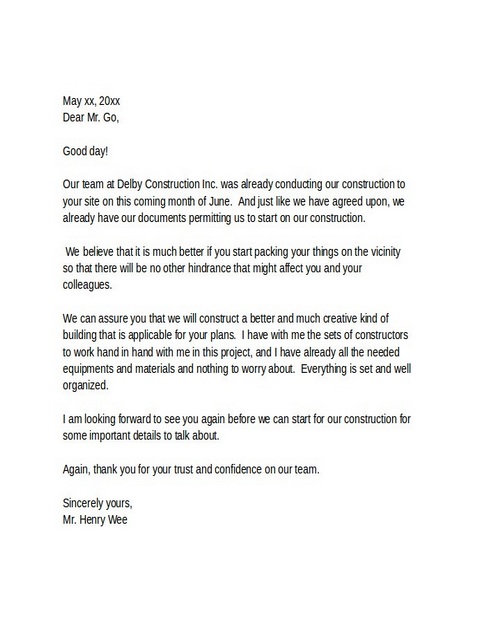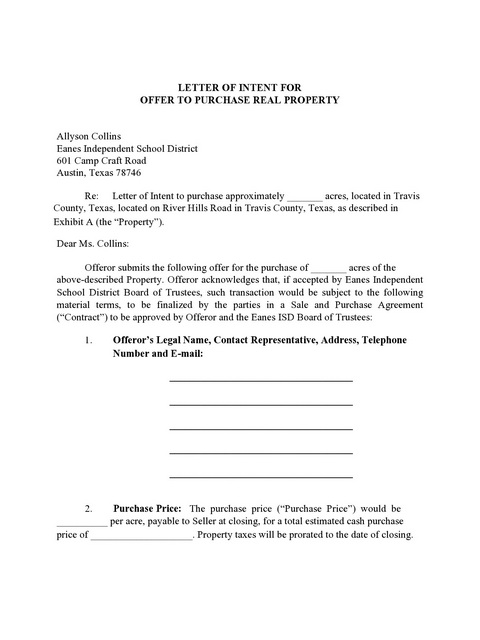A real estate letter of intent covers the entire scope of a potential property sale agreement. This type of document is used as the centerpiece for a real estate transaction, binding the buyers and sellers together as partners.
This means that unless the document is included, there can be no legally binding transaction. Here is a basic real estate letter of intent example, which can be used as a general guide to this complicated and potentially lucrative field.
Real Estate Letter of Intent

Step to Create Real Estate letter of Intent
The are some important steps to create a real estate letter of content :
1. This is the first step in creating a letter.
You’ll need to gather the necessary information to complete your form, which includes: the name of both parties, names of their attorneys, a complete disclosure of all liabilities and damages, and a clear outline of the total cost breakdown (in addition to the down payment to be made).
This step is extremely important, as it ensures that there is absolutely no misunderstanding about any part of your contract during the legal proceedings leading up to a sale.
You should also gather the signatures of both sellers and buyers, to ensure that the document’s terms are official and legally binding. (Many people inadvertently indicate to a buyer that they have their own agent, when in reality their agent is just sitting in their office, signing papers.)
2. The next step is to fill out the basic terms section of your letter.
This is where you include the name of your buyer and seller, the number of months the property is for lease, the due date for rent, and any clause relating to late rent, damage deposits, and so on. Some real estate documents have specific prerequisites for the presence of certain items, such as rent payments. These requirements must be met in order for your letter to be binding. Additionally, the letter will list the commission and other sales price of the property, the amount due to the seller, and all necessary contingencies.
3. Next, the parties must agree on the scope of negotiations.
In this section, the two parties must state what areas of negotiations will be discussed, when those negotiations will begin, and what each party will do to resolve issues before those negotiations begin. To make things easier, you can list the dates and times of the preliminary discussions, as well as their locations.
This will help give you an accurate timeline of your time-frame and better-understand how to move forward with your negotiations. If possible, you should consider having someone representing each party appear at all meetings with the other party.
If negotiations fall through, there is an outline of what will occur in due diligence. Real Estate Letter of Intent can also outline the due diligence process, including the steps that will be taken once the offer has been received, if the seller accepts, and if there is any contract negotiations.
Real Estate Letters of Intent also outline the legal steps that will need to be taken in order to transfer the property, including any court actions, if necessary, and the costs associated with such transfer.
There are many instances where a commercial property owner may be stumped by the request for information regarding an intent to bid or accept a bid. Real Estate Letter of Intent (loi) is a very helpful tool, as it will outline all of the necessary steps that must be taken during the due diligence process.
A real estate letter of intent (loi) is a legal document, which certifies that the seller has met all of the requirements to take a certain action but has not yet actually done so.
4. You should create a legal proposal.
Once you have all of the required information, you should create a legal proposal. The real letter is legally binding, and the seller must respond to the buyer in writing. If a buyer does not respond to your proposal in a timely manner, then the letter is not legally binding.
You may, however, want to get the help of an attorney to review the proposal and provide legal counsel to either agree with or dispute the facts contained in the letter. If a buyer agrees with the letter, the sale can proceed.
Real Estate letter of Intent Template

Commercial Real Estate letter of Intent

Real Estate letter of Intent Sample

Real Estate letter of Intent to Lease

Real Estate letter of Intent To Purchase Property

Free Real Estate letter of Intent

Florida Real Estate letter of Intent



The letter does not represent the final contractual agreement in any transaction, as the sale is still pending acceptance or refusal by both parties. To protect both yourself and the company, it is important to make sure that you can fully explain all of the terms contained in the document, as well as any events that may take place between the time that you send the letter and when the deal closes.
Any agreements that are written into a letter of intent should be clearly spelled out, and include all of the necessary dates. In some cases, such as commercial real estate transactions, it may be wise to consider using an attorney. This ensures that everything is legally binding, and will offer legal counsel if needed throughout the transaction.